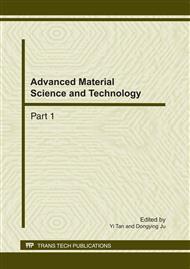p.9
p.15
p.21
p.29
p.33
p.37
p.41
p.45
p.49
Amorphous Ni-Co-B Catalyst for Hydrolysis of NaBH4 in Alkaline Solution
Abstract:
Amorphous Ni-Co-B catalyst was synthesized by a chemical reduction method, and followed by a heat-treating at 100°C, then characterized by X-ray diffraction (XRD), Scanning electronic microscopy (SEM), X-ray photoelectron spectroscopy (XPS), Brunauer-Emmetr-Teller (BET) analysis, and adopted to help accelerating hydrolysis reaction of NaBH4 alkaline solution. It is proved that the amorphous Ni-Co-B catalyst is not a simple combination of elemental Ni, Co and B, but a multiplex metal boride. It exhibits an maximum hydrogen generation rate of 210 ml/min/(g catalyst) at 100% H2 utilization, which is potentially to give a successive H2 supply for proton exchange membrane fuel cells.
Info:
Periodical:
Pages:
33-36
Citation:
Online since:
February 2011
Authors:
Price:
Сopyright:
© 2011 Trans Tech Publications Ltd. All Rights Reserved
Share:
Citation:


